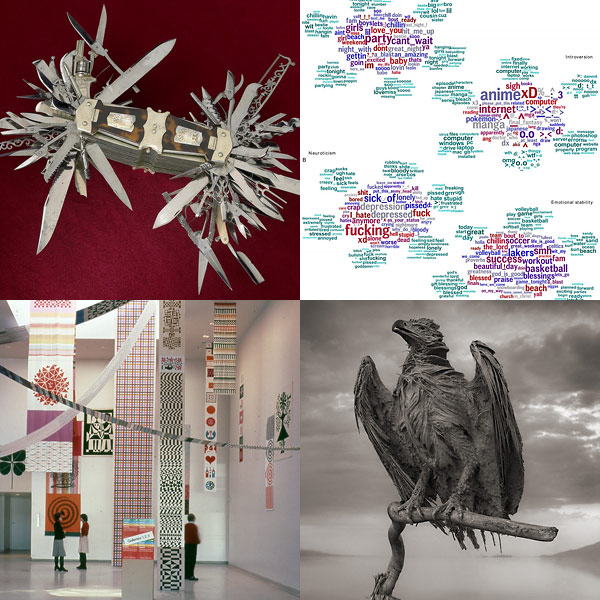Link About It: This Week’s Picks
Modular phones, petrified bird photography, the Empire State Building’s green roof and more in our weekly look at the web


1. The Ultimate Swiss Army Knife
Cumbersome? Yes. Ornate? Certainly. Over the top? Absolutely. The Wenger 16999 Swiss Army Knife from around 1880 has roughly 100 functions—some necessary and some superfluous. From a built-in saw to a piano tuner, this knife can help with just about any pre-digital task. It even has a fully functioning .22 caliber pinfire revolver for those impromptu duel challenges. Regardless of its ridiculousness, the knife is a feat of craftsmanship and ingenuity for its time.
2. A Phone Worth Keeping
When your phone dies, generally only one component has stopped working. Phonebloks is proposing a forward-thinking system—a modular phone built of replaceable and customizable parts, that could be repaired in the same way we fix cars. The message is sweeping the globe right now via the viral amplification service Thunderclap, where a video explains not only the issue with electronic waste but that this problem can be remedied with enough support. Phonebloks is aiming for enough reach that—on 29 October 2013—a unified mass of 900,000 backers will send a social media message of support at the same time.
3. Growing Graffiti Moss
Seemingly everyone is into growing moss script and graffiti these days, but there’s one girl who has it down to a science. Anna Garforth’s artwork thrives—it’s beautiful when it goes up, and even more interesting as it continues to grow and evolve. Inspired by the moss growing in the script on old grave stones, Garforth initially experimented in written graffiti and eventually mastered her technique. So much so that she now also produces large-scale graphic projects that cover entire walls and building facades. Head to Designboom to check out photos and read the interview on her mastery of moss.
4. The Psychology of Language on Facebook
As part of the World Well-Being Project, which leads initiatives to analyze social media’s big data for application to psychological theory, a new University of Pennsylvania study is sharing insights on the internet’s linguistic and personality trends. Amassing 75,000 volunteers, researchers examined status updates containing over 700 million words, phrases and topics. Through predictive analysis, they were able to match language with simple personality questionnaires, and with striking accuracy they revealed age, gender and personality type. The impact of the emotional and cultural tides online can benefit psychological understanding. Another upside to this new “open-vocabulary approach” to research is that it could replace the need for surveys, with future studies only requiring a volunteer’s consent.

5. Revisiting 1950s Design
In the spring of 1952, famed designers George Nelson, Charles Eames and Alexander Girard hosted a “Sample Lesson” before an overflowing audience in LA. These designers, who still stand for the most important and lasting design era guiding designers today, hosted the event in response to a need to rethink art and design in education. Mickey Friedman—a star graduate student at the time and later a curator for the Walker Art Museum—attended each of the events and followed up with interviews with each of the designers. Friedman’s records shed a new light on the comprehensive design collaboration, rejuvenating the legendary lectures’ clarity and educational value. Read on with Herman Miller.
6. Pixote + Fool’s Gold + SHUT NYC
NYC-via-Rio de Janeiro graffiti legend Pixote is known for making the Lower East Side his personal studio. Partnering with Manhattan’s SHUT Skateboards and Brooklyn-based record label Fool’s Gold is a natural fit for the street artist; a skateboarder himself. In a rare interview with 12oz Prophet, Pixote discusses the current collaboration as well as his work as a street artist in NYC. Though he’s been in the States for 16 years, his Brazilian roots still impact both his work and the way he sees graffiti. The interview offers valuable insight into his life and work.
7. Lethal Lakes
British photographer Nick Brandt is renowned for documenting the vanishing of magnificent wild animals in East Africa on black and white film. In most cases the animals have been alive, but Brandt’s newest subjects are petrified creatures found in Lake Natron in northern Tanzania. Because the lake neighbors a volcano, its water has an extremely high soda and salt content that perfectly preserves any misfortunate animal that lands in it—becoming a literal “Dead Sea.”
8. Garden State of Mind
In true New York fashion, a LEED Gold certification wasn’t enough for the Empire State Building. The iconic landmark raised its own bar even higher by installing four new green roofs, allowing tenants to enjoy a relaxing lunch by a garden oasis without ever leaving the building. The newly planted greenery benefits more than just tenants; they cleanse rain as stormwater run-off filters, reduce greenhouse gases, help absorb solar gain and filter dust and pollutants. Hopefully this is a trend that other buildings in the city will hasten to follow.
Link About It is our filtered look at the web, shared daily on Twitter and published weekly every Saturday morning.










